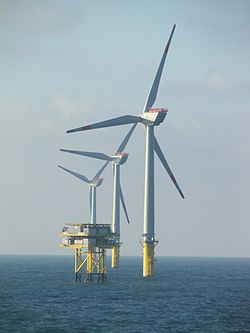
Back طاقة رياح بحرية Arabic Energia eòlica marina Catalan Větrné turbíny na moři Czech Offshore-vindenergi Danish Energía eólica marina Spanish نیروگاه بادی دریایی Persian Merituulivoima Finnish Tenaga angin lepas pantai ID Eolico offshore Italian 洋上風力発電 Japanese

Offshore wind power or offshore wind energy is the generation of electricity through wind farms in bodies of water, usually at sea. There are higher wind speeds offshore than on land, so offshore farms generate more electricity per amount of capacity installed.[1] Offshore wind farms are also less controversial[2] than those on land, as they have less impact on people and the landscape.
Unlike the typical use of the term "offshore" in the marine industry, offshore wind power includes inshore water areas such as lakes, fjords and sheltered coastal areas as well as deeper-water areas. Most offshore wind farms employ fixed-foundation wind turbines in relatively shallow water. Floating wind turbines for deeper waters are in an earlier phase of development and deployment.
As of 2022, the total worldwide offshore wind power nameplate capacity was 64.3 gigawatt (GW).[3] China (49%), the United Kingdom (22%), and Germany (13%) account for more than 75% of the global installed capacity.[3] The 1.4 GW Hornsea Project Two in the United Kingdom was the world's largest offshore wind farm. Other projects in the planning stage include Dogger Bank in the United Kingdom at 4.8 GW, and Greater Changhua in Taiwan at 2.4 GW.[4]
The cost of offshore has historically been higher than that of onshore,[5] but costs decreased to $78/MWh in 2019.[6] Offshore wind power in Europe became price-competitive with conventional power sources in 2017.[7] Offshore wind generation grew at over 30 percent per year in the 2010s. As of 2020, offshore wind power had become a significant part of northern Europe power generation, though it remained less than 1 percent of overall world electricity generation.[8] A big advantage of offshore wind power compared to onshore wind power is the higher capacity factor meaning that an installation of given nameplate capacity will produce more electricity at a site with more consistent and stronger wind which is usually found offshore and only at very few specific points onshore.
- ^ Madsen & Krogsgaard. Offshore Wind Power 2010 Archived 30 June 2011 at the Wayback Machine BTM Consult, 22 November 2010. Retrieved: 22 November 2010.
- ^ Vloemans, Pepijn (27 January 2022). "Energia per tutti". Internazionale (in Italian). Retrieved 1 February 2023.
- ^ a b Hutchinson, Mark; Zhao, Feng (17 June 2023) [27 March 2023]. "Global Wind Report 2023" (PDF). Global Wind Energy Council. pp. 8, 99.
- ^ "Orsted clears Taiwan hurdle". reNEWS - Renewable Energy News. 6 December 2017. Retrieved 7 December 2017.
- ^ Cite error: The named reference
eia2010dec16was invoked but never defined (see the help page). - ^ Lee, Andrew (22 October 2019). "Offshore wind power price plunges by a third in a year". Recharge | Renewable energy news and articles.
- ^ "After a decade of dithering, the US east coast went all in on offshore wind power this week". Archived from the original on 29 September 2018. Retrieved 29 September 2018.
- ^ Reed, Stanley (4 June 2020). "A New Weapon Against Climate Change May Float". The New York Times. Retrieved 10 June 2020.
© MMXXIII Rich X Search. We shall prevail. All rights reserved. Rich X Search